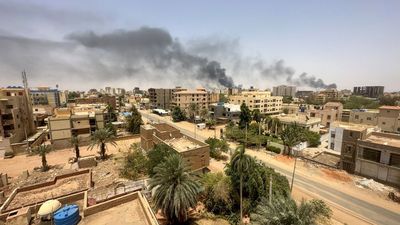Here is Everything We Know About The Ongoing Sudan Crisis
In the wake of Sudan’s unrest, there have been many updates. Here is what we know so far.
On Saturday, April 15, violence erupted between the Sudanese Armed Forces (SAF) and Khartoum's Rapid Support Forces (RSF), leaving hundreds dead and thousands injured. This was spurred by a dispute over power between different military groups that broke out following the unsuccessful attempt to switch to a government led by civilians. As more details regarding the unrest surface, here is what we know so far about what is going on.
What Triggered The Crisis?
On April 15, the turmoil began amid a political power struggle between the two primary factions within Sudan's military regime, namely the Sudanese Armed Forces (SAF), who predominantly support Gen. Abdel Fattah al-Burhan, the nation's current leader, and the paramilitaries of the Rapid Support Forces (RSF), an assemblage of militias, who are loyal to former warlord Gen. Mohamed Hamdan Dagalo also known as Hemedti. According to reports, the ongoing crisis in Khartoum—Sudan's capital city—was triggered by a long-standing feud between the two generals vying for power and control.
What's the history?
The current tension’s origin trace back to the years preceding the April 2019 uprising, which ultimately deposed the autocratic ruler Omar al-Bashir. At the time, Sudan found itself in the grip of a fierce struggle as its two rival armies disagreed over the restoration of civilian rule following al-Bashir’s removal from power.
On Oct. 25, 2021, the military detained civilian members of a power-sharing transitional council that was established in the wake of Bashir's exit. Among those arrested was Prime Minister Abdalla Hamdok. Following the arrests, a state of emergency was declared, and security forces were responsible for the deaths of seven protesters and the injury of dozens more amid the chaos. In response to the clash, the United States and the World Bank halted crucial aid to Sudan, which further heightened the tension. The African Union suspended Sudan, and army chief Abdel Fattah al-Burhan — who has served as Sudan's leader since Bashir's overthrow — established a new ruling council under his leadership. According to Barron’s report, the primary group advocating for civilian rule was notably excluded from this council.
How did it come to bloodshed?
On Nov. 21, 2021, Burhan agreed to resume the transition to civilian rule, scheduling elections for July 2023. Abdalla Hamdok was reinstated as prime minister, and several civilian leaders were released from prison. In spite of all of the changes, the suppression of pro-democracy protests persisted, leading to Hamdok's resignation in January 2022. Despite mediation attempts by the United Nations, there was no progress made and efforts to start negotiations quickly fell through after civilians protested. On July 4, Burhan confirmed that the army would be withdrawing from negotiations, and would give civilians an opportunity to form a government, but this was met with widespread skepticism.
On Dec. 5, 2022, Sudan's military, paramilitary, and several civilian leaders signed a provisional agreement aimed at restoring the civilian transition within two years. However, protesters argue that the leaders dismissed their calls for justice regarding the death of over 120 pro-democracy demonstrators killed since Burhan's coup.
All of the tensions continued to build up over the span of months, and on April 13 of this year, the Sudanese army warned that the country was at a "dangerous... turning point." Two days later, explosions and gunfire are heard in Khartoum. Both sides accuse the other of instigating the violence.
What's the current situation?
Following al-Bashir's ouster, failed attempts to transition to a democratic, civilian-led government set the pace for the brewing clash that is currently happening. The violence has claimed the lives of hundreds. So far, the World Health Organization has confirmed that over 450 civilians have been killed and over 4,000 injured as a result of the unrest across the country. According to reports, the actual mortality count could be much higher. Although most of the fighting is happening in Khartoum, other violent clashes have reportedly occurred throughout the expansive nation.
How is the progress of evacuation?
The fighting in Khartoum has displaced many people, and left others struggling to survive without access to electricity or water, The New York Times reports. In the past, diplomats were able to avoid getting caught in the crosshairs of the tension, but in the wake of this unrest, things are different. Countries like the United States, France, Canada, and recently South Africa, among others, have evacuated their nationals from the embattled country. Since the violence erupted, there have been several failed attempts to establish a ceasefire.
Over the past few months, international heavyweights like the United Nations and the United States have attempted to urge the two generals, urging them to facilitate a shift towards a government led by civilians to no avail. On Tuesday, the sound of gunfire in the capital ended a fourth attempt at a cease-fire in the region, but according to The Washington Post, several residents said that a few neighborhoods were quiet enough in the morning for families to flee for their safety.
- Music, Identity & War In Sudan: Beats Of The Antonov Debuts Online ›
- Nigerian Students in Sudan Call Out Their Government For Neglect ›
- New Sudanese Peace Deal Ends Seventeen Year Civil War ›
- Sudanese Forces Agree to Protect Civilians, While Rejecting Cease-Fire Efforts - OkayAfrica ›
- Sudan Army Hits Huge Milestone with Presidential Palace Recapture | OkayAfrica ›
- Judiya, An Ancient Peace-Making Tradition, Gains New Relevance in Sudan | OkayAfrica ›
